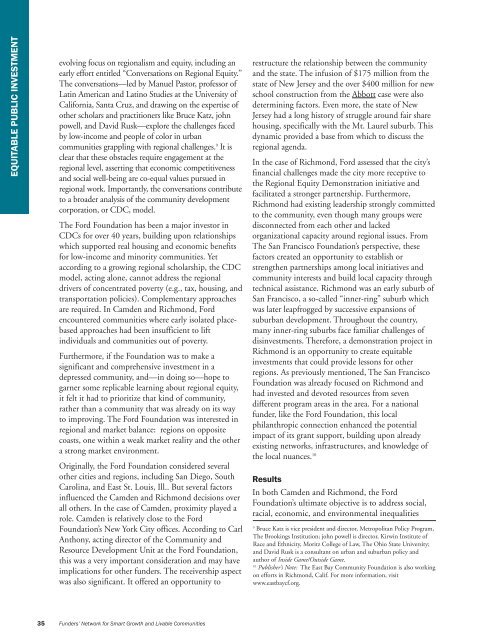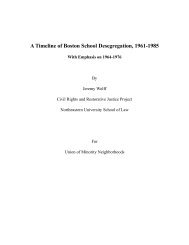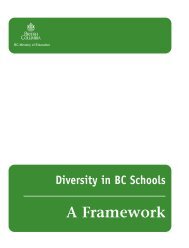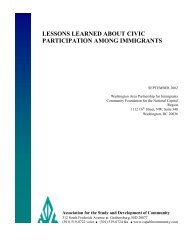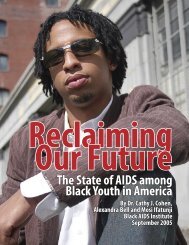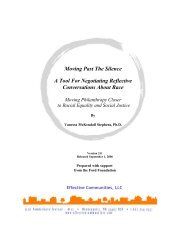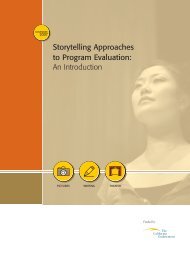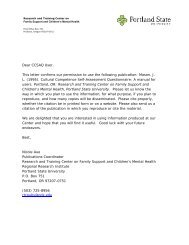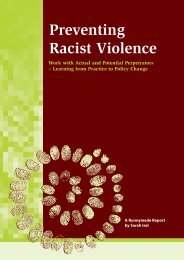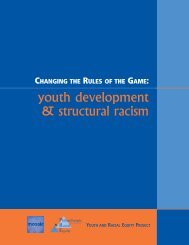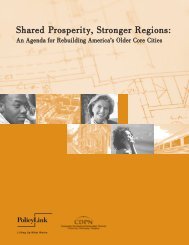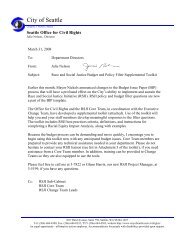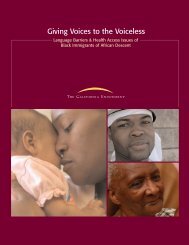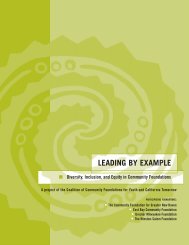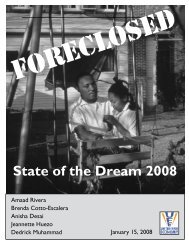EQUITABLE PUBLIC INVESTMENTevolv<strong>in</strong>g focus on regionalism <strong>and</strong> equity, <strong>in</strong>clud<strong>in</strong>g anearly effort entitled “Conversations on <strong>Regional</strong> Equity.”The conversations—led by Manuel Pastor, pr<strong>of</strong>essor <strong>of</strong>Lat<strong>in</strong> American <strong>and</strong> Lat<strong>in</strong>o Studies at the University <strong>of</strong>California, Santa Cruz, <strong>and</strong> draw<strong>in</strong>g on the expertise <strong>of</strong>other scholars <strong>and</strong> practitioners like Bruce Katz, johnpowell, <strong>and</strong> David Rusk—explore the challenges facedby low-<strong>in</strong>come <strong>and</strong> people <strong>of</strong> color <strong>in</strong> urbancommunities grappl<strong>in</strong>g with regional challenges. 9 It isclear that these obstacles require engagement at theregional level, assert<strong>in</strong>g that economic competitiveness<strong>and</strong> social well-be<strong>in</strong>g are co-equal values pursued <strong>in</strong>regional work. Importantly, the conversations contributeto a broader analysis <strong>of</strong> the community developmentcorporation, or CDC, model.The Ford Foundation has been a major <strong>in</strong>vestor <strong>in</strong>CDCs for over 40 years, build<strong>in</strong>g upon relationshipswhich supported real hous<strong>in</strong>g <strong>and</strong> economic benefitsfor low-<strong>in</strong>come <strong>and</strong> m<strong>in</strong>ority communities. Yetaccord<strong>in</strong>g to a grow<strong>in</strong>g regional scholarship, the CDCmodel, act<strong>in</strong>g alone, cannot address the regionaldrivers <strong>of</strong> concentrated poverty (e.g., tax, hous<strong>in</strong>g, <strong>and</strong>transportation policies). Complementary approachesare required. In Camden <strong>and</strong> Richmond, Fordencountered communities where early isolated placebasedapproaches had been <strong>in</strong>sufficient to lift<strong>in</strong>dividuals <strong>and</strong> communities out <strong>of</strong> poverty.Furthermore, if the Foundation was to make asignificant <strong>and</strong> comprehensive <strong>in</strong>vestment <strong>in</strong> adepressed community, <strong>and</strong>—<strong>in</strong> do<strong>in</strong>g so—hope togarner some replicable learn<strong>in</strong>g about regional equity,it felt it had to prioritize that k<strong>in</strong>d <strong>of</strong> community,rather than a community that was already on its wayto improv<strong>in</strong>g. The Ford Foundation was <strong>in</strong>terested <strong>in</strong>regional <strong>and</strong> market balance: regions on oppositecoasts, one with<strong>in</strong> a weak market reality <strong>and</strong> the othera strong market environment.Orig<strong>in</strong>ally, the Ford Foundation considered severalother cities <strong>and</strong> regions, <strong>in</strong>clud<strong>in</strong>g San Diego, SouthCarol<strong>in</strong>a, <strong>and</strong> East St. Louis, Ill.. But several factors<strong>in</strong>fluenced the Camden <strong>and</strong> Richmond decisions overall others. In the case <strong>of</strong> Camden, proximity played arole. Camden is relatively close to the FordFoundation’s New York City <strong>of</strong>fices. Accord<strong>in</strong>g to CarlAnthony, act<strong>in</strong>g director <strong>of</strong> the Community <strong>and</strong>Resource Development Unit at the Ford Foundation,this was a very important consideration <strong>and</strong> may haveimplications for other funders. The receivership aspectwas also significant. It <strong>of</strong>fered an opportunity torestructure the relationship between the community<strong>and</strong> the state. The <strong>in</strong>fusion <strong>of</strong> $175 million from thestate <strong>of</strong> New Jersey <strong>and</strong> the over $400 million for newschool construction from the Abbott case were alsodeterm<strong>in</strong><strong>in</strong>g factors. Even more, the state <strong>of</strong> NewJersey had a long history <strong>of</strong> struggle around fair sharehous<strong>in</strong>g, specifically with the Mt. Laurel suburb. Thisdynamic provided a base from which to discuss theregional agenda.In the case <strong>of</strong> Richmond, Ford assessed that the city’sf<strong>in</strong>ancial challenges made the city more receptive tothe <strong>Regional</strong> Equity Demonstration <strong>in</strong>itiative <strong>and</strong>facilitated a stronger partnership. Furthermore,Richmond had exist<strong>in</strong>g leadership strongly committedto the community, even though many groups weredisconnected from each other <strong>and</strong> lackedorganizational capacity around regional issues. FromThe San Francisco Foundation’s perspective, thesefactors created an opportunity to establish orstrengthen partnerships among local <strong>in</strong>itiatives <strong>and</strong>community <strong>in</strong>terests <strong>and</strong> build local capacity throughtechnical assistance. Richmond was an early suburb <strong>of</strong>San Francisco, a so-called “<strong>in</strong>ner-r<strong>in</strong>g” suburb whichwas later leapfrogged by successive expansions <strong>of</strong>suburban development. Throughout the country,many <strong>in</strong>ner-r<strong>in</strong>g suburbs face familiar challenges <strong>of</strong>dis<strong>in</strong>vestments. Therefore, a demonstration project <strong>in</strong>Richmond is an opportunity to create equitable<strong>in</strong>vestments that could provide lessons for otherregions. As previously mentioned, The San FranciscoFoundation was already focused on Richmond <strong>and</strong>had <strong>in</strong>vested <strong>and</strong> devoted resources from sevendifferent program areas <strong>in</strong> the area. For a nationalfunder, like the Ford Foundation, this localphilanthropic connection enhanced the potentialimpact <strong>of</strong> its grant support, build<strong>in</strong>g upon alreadyexist<strong>in</strong>g networks, <strong>in</strong>frastructures, <strong>and</strong> knowledge <strong>of</strong>the local nuances. 10ResultsIn both Camden <strong>and</strong> Richmond, the FordFoundation’s ultimate objective is to address social,racial, economic, <strong>and</strong> environmental <strong>in</strong>equalities9Bruce Katz is vice president <strong>and</strong> director, Metropolitan Policy Program,The Brook<strong>in</strong>gs Institution; john powell is director, Kirw<strong>in</strong> Institute <strong>of</strong>Race <strong>and</strong> Ethnicity, Moritz College <strong>of</strong> Law, The Ohio State University;<strong>and</strong> David Rusk is a consultant on urban <strong>and</strong> suburban policy <strong>and</strong>author <strong>of</strong> Inside Game/Outside Game.10Publisher’s Note: The East Bay Community Foundation is also work<strong>in</strong>gon efforts <strong>in</strong> Richmond, Calif. For more <strong>in</strong>formation, visitwww.eastbaycf.org.35Funders’ Network for Smart Growth <strong>and</strong> Livable Communities
through policy reform at the local <strong>and</strong> state levels<strong>and</strong> advance a regional perspective as the lensthrough which to approach poverty <strong>and</strong> segregation.As the demonstrations progress, each site will havearticulated, pursued,In both Camden <strong>and</strong>Richmond, the FordFoundation’s ultimateobjective is to address social,racial, economic, <strong>and</strong>environmental <strong>in</strong>equalitiesthrough policy reform at thelocal <strong>and</strong> state levels <strong>and</strong>advance a regionalperspective as the lensthrough which to approachpoverty <strong>and</strong> segregation.<strong>and</strong> documented aunique approach tol<strong>in</strong>k<strong>in</strong>g marg<strong>in</strong>alizedplaces <strong>and</strong> people toregionalopportunities <strong>and</strong>will have participated<strong>in</strong> <strong>and</strong> contributed toa learn<strong>in</strong>g network <strong>of</strong>peers pursu<strong>in</strong>gsimilar work <strong>in</strong> otherareas <strong>of</strong> the country.Ford anticipatesmeasurable <strong>and</strong>significant results willbe realized <strong>in</strong> Camden, made possible <strong>in</strong> part by theresources provided through the demonstrationproject. The vision is that the CRA will improve thepr<strong>of</strong>essional staff, systems, <strong>and</strong> resources needed t<strong>of</strong>unction effectively on behalf <strong>of</strong> the cont<strong>in</strong>u<strong>in</strong>gimprovement <strong>of</strong> the city. Redevelopedneighborhoods will have improved by attract<strong>in</strong>gmixed-<strong>in</strong>come residents, provid<strong>in</strong>g exp<strong>and</strong>ed choice<strong>and</strong> opportunities for city residents, <strong>and</strong> <strong>in</strong>creas<strong>in</strong>grevenues for the city budget. A cadre <strong>of</strong> <strong>in</strong>vested <strong>and</strong>engaged citizens will have emerged. Affordablehous<strong>in</strong>g throughout the Camden metropolitanregion will be operat<strong>in</strong>g <strong>in</strong> collaboration withmunicipalities <strong>and</strong> private developers. Furthermore,the restoration <strong>and</strong> redevelopment <strong>of</strong> Camden’s parkswill be ongo<strong>in</strong>g, with <strong>in</strong>creas<strong>in</strong>g public <strong>and</strong> privatesupport for the value <strong>of</strong> open space to neighborhoods<strong>and</strong> schools. On the employment development front,a network <strong>of</strong> workforce organizations are tapp<strong>in</strong>g<strong>in</strong>to the New Jersey <strong>and</strong> Philadelphia economies <strong>and</strong>provid<strong>in</strong>g tangible opportunities for Camdenresidents to work productively throughout theregion. The state’s policy will also be impacted as an<strong>in</strong>fluential, statewide, multi-racial advocacyorganization will be <strong>in</strong> place <strong>in</strong> New Jersey carry<strong>in</strong>gout a regional equity policy reform agenda. Funderswill cont<strong>in</strong>ue to be <strong>in</strong>volved <strong>in</strong> the region, as anetwork <strong>of</strong> private foundations <strong>and</strong> corporations willbe actively engaged <strong>in</strong> fund<strong>in</strong>g regional equity work<strong>in</strong> the Camden region.Both Ford <strong>and</strong> The San Francisco Foundation<strong>in</strong>dicate that Richmond has a tremendous amount <strong>of</strong>local leadership, but are too <strong>of</strong>ten not work<strong>in</strong>gtogether effectively. The Richmond demonstrationproject is an opportunity to br<strong>in</strong>g diverse groupstogether around an <strong>in</strong>clusive agenda. Accord<strong>in</strong>g toThe San Francisco Foundation’s Rodriguez, theRichmond Initiative should help build a communitylevelunderst<strong>and</strong><strong>in</strong>g <strong>of</strong> community needs <strong>and</strong>successfully l<strong>in</strong>k those issues to larger regional issues<strong>and</strong> decisionmak<strong>in</strong>g processes. A key goal for theproject is susta<strong>in</strong>ability <strong>and</strong> local capacitydevelopment. The work <strong>in</strong> Richmond is not a shorttermeffort, <strong>and</strong> the anchor groups as well as otherfuture project partners need the <strong>in</strong>ternal capacity tocont<strong>in</strong>ue <strong>and</strong> exp<strong>and</strong> the work when the currentFord/San Francisco Foundation fund<strong>in</strong>g stream isreduced or ends.Lessons LearnedCamden <strong>and</strong> Richmond have provided very differentlessons, mostly the result <strong>of</strong> their differentcharacteristics (weak market versus strong market)<strong>and</strong> Ford’s different approaches (project/asset-basedregionalism versus need/community-basedregionalism).Camden has no functional city government <strong>and</strong>Ford believes similar challenges will likely beencountered <strong>in</strong> other small cities located <strong>in</strong>decl<strong>in</strong><strong>in</strong>g regions. In weak markets like Camden,governmental functions <strong>and</strong> supports are either<strong>in</strong>adequate or non-existent. Therefore, a fundershould anticipate devot<strong>in</strong>g significant resourcestoward <strong>in</strong>frastructure <strong>and</strong> capacity build<strong>in</strong>g. Afunder’s <strong>in</strong>vestment <strong>in</strong> an older <strong>and</strong> weak marketcity requires a unique strategy to build on a city’sexist<strong>in</strong>g strengths as opposed to <strong>in</strong>vest<strong>in</strong>g based ona community’s needs. In Camden, this meansfocus<strong>in</strong>g on the potential strengths <strong>in</strong> the realestate market. When lack<strong>in</strong>g a mean<strong>in</strong>gful civic<strong>in</strong>frastructure—because <strong>of</strong> residents’ apathy,government corruption, <strong>and</strong> other factors—funderssupport<strong>in</strong>g broader community revitalization needto devote their resources to the emergence <strong>of</strong> ahealthy civic <strong>in</strong>frastructure. Funders should alsoevaluate the negative/positive impact <strong>of</strong> the localpublic <strong>in</strong>frastructure. For example, <strong>in</strong> Camden, thebroader public <strong>in</strong>frastructure (other cities, stategovernment) actually <strong>in</strong>hibits Camden’sdevelopment. Camden is home to many projectsEQUITABLE PUBLIC INVESTMENTPart III: Section 1: Promot<strong>in</strong>g Equitable Public Investment 36
- Page 1 and 2: Stories of Philanthropic Leadership
- Page 3 and 4: Signs of Promise:Stories of Philant
- Page 5 and 6: Funders’ Network for Smart Growth
- Page 7 and 8: (II. B.)(II. C.)Turning Neighborhoo
- Page 9 and 10: PART I:IntroductionThe Purpose of t
- Page 11 and 12: social justice issues as they relat
- Page 13 and 14: PART II:Perspectives on Advancing R
- Page 15 and 16: peer work, we can reestablish a sig
- Page 17 and 18: Annie E. Casey FoundationBaltimore,
- Page 19 and 20: neighborhoods into healthy ones—g
- Page 21 and 22: Charles and Helen Schwab Foundation
- Page 23 and 24: Section 1:Promoting Equitable Publi
- Page 25 and 26: I. A. BUILDING POWER AND GIVINGVOIC
- Page 27 and 28: policy advocates. In 2002, Milwauke
- Page 29 and 30: in Los Angeles, Ford’s Anthony no
- Page 31 and 32: I. B. PROMOTING COALITIONSTO ADVANC
- Page 33 and 34: Yet the interpersonal dynamics of c
- Page 35 and 36: guidelines. “Many of the member o
- Page 37 and 38: Funder InterestThe EPA supported th
- Page 39 and 40: I. D. DEMONSTRATING THESTRUGGLE FOR
- Page 41: Richmond, Calif.The second regional
- Page 45 and 46: I. E. BUILDING COALITIONTHROUGH KNO
- Page 47 and 48: organizing project, the Connecticut
- Page 49 and 50: and businesses are quantified in a
- Page 51 and 52: I. G. REVITALIZING WHILEASSURING DI
- Page 53 and 54: In the late 1990s, the city of Albu
- Page 55 and 56: I. H. A TRAVEZ DE LA FRONTERA:LAND
- Page 57 and 58: The International Community Foundat
- Page 59 and 60: I. I. MOBILIZING ACTION FORREGIONAL
- Page 61 and 62: To meet all of these objectives, th
- Page 63 and 64: efforts. And with each public plann
- Page 65 and 66: pattern of disproportionate transpo
- Page 67 and 68: Clinica de la Raza identify this cr
- Page 69 and 70: Contact PeopleCarl AnthonyActing Di
- Page 71 and 72: Section 2:Making All Neighborhoods
- Page 73 and 74: II. A. REACHING BEYONDHOUSING TO IM
- Page 75 and 76: A local resident receives the keys
- Page 77 and 78: East Baltimore community and the Jo
- Page 79 and 80: example, adjacent to the EBDI area,
- Page 81 and 82: II. C. YIELDING REGIONALBENEFITS TH
- Page 83 and 84: is using transit-oriented developme
- Page 85 and 86: financing and innovative, forward-t
- Page 87 and 88: The Row House Community Development
- Page 89 and 90: II. E. COUNTERING THE PERFECTSTORM:
- Page 91 and 92: funded community programs, includin
- Page 93 and 94:
housing developments and commercial
- Page 95 and 96:
owned enterprises, totaling $8.5 mi
- Page 97 and 98:
LOAN GUARANTEESSection 3:Connecting
- Page 99 and 100:
III. A. MAKING HOUSING ANOPPORTUNIT
- Page 101 and 102:
A new report from the National Hous
- Page 103 and 104:
The Straphangers Campaign was found
- Page 105 and 106:
Funder InterestThe Straphangers Cam
- Page 107 and 108:
or increase poverty. Whether direct
- Page 109 and 110:
The Regional Plan Association then
- Page 111 and 112:
multi-stakeholder effort composed o
- Page 113 and 114:
director with LISC. No one set of s
- Page 115 and 116:
12 western Louisville neighborhoods
- Page 117 and 118:
III. E. UNITING THREE STATESFOR ONE
- Page 119 and 120:
increased their personal wealth by
- Page 121 and 122:
summary evaluation of MSDI found th
- Page 123 and 124:
method alone was strong enough to m
- Page 125 and 126:
consistent body of work. The Counci
- Page 127 and 128:
3) Issues Need to be ConnectedThe f
- Page 129 and 130:
PART V:Glossary of TermsThe terms d
- Page 131 and 132:
Regional and neighborhood equity. A
- Page 133 and 134:
Tijuana River Reserve, California:h
- Page 135 and 136:
Sargent Shriver National Center on
- Page 137:
1500 San Remo Avenue • Suite 249


